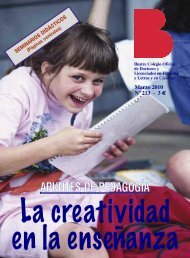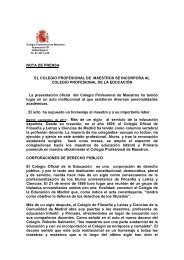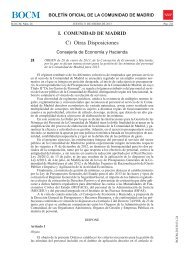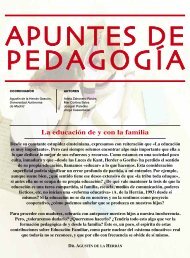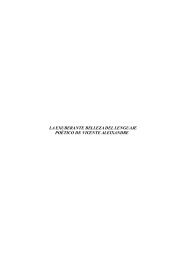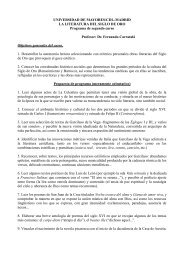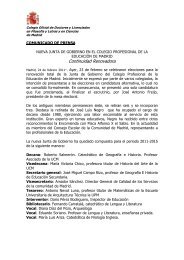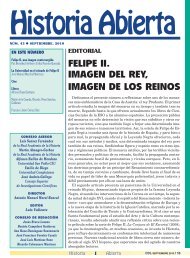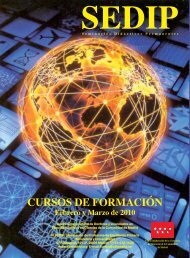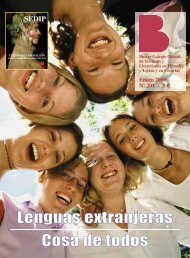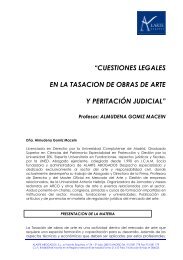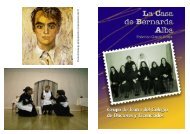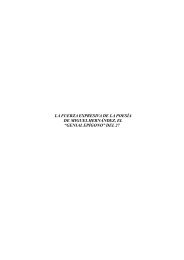The Golden Section and the Piano Sonatas of Mozart John F. Putz ...
The Golden Section and the Piano Sonatas of Mozart John F. Putz ...
The Golden Section and the Piano Sonatas of Mozart John F. Putz ...
Create successful ePaper yourself
Turn your PDF publications into a flip-book with our unique Google optimized e-Paper software.
VOL. 68, NO. 4, OCTOBER 1995 2 79FIGURE 7 FIGURE 8Scatter plot <strong>of</strong> a against b. Scatter plot <strong>of</strong> a against b with <strong>the</strong> liney = (px (bottom) <strong>and</strong> <strong>the</strong> regression line (top).1FIGURE 9Frequency distribution <strong>of</strong> 5 bTHEOREM. - where O
2 80 MATHEMATICS MAGAZINEThus we know that, given any pair a <strong>and</strong> b, 0 < a < b, <strong>the</strong> ratio b/(a + b) will becloser to cpthan a/b will. An enthusiast wishing to demonstrate a golden ratiorelationship between, say, shoe size s <strong>and</strong> ACT score t, should present data in <strong>the</strong>form t/(s + t) instead <strong>of</strong> s/t, because t/(s + t) will be biased toward cp. Table 2shows some data to demonstrate this. As <strong>the</strong> <strong>the</strong>orem predicts, in every case t/(s +t)is nearer to 0.6180 than s/t is. One lesson to be learned from this is clear: If we areto analyze data in this way, <strong>the</strong>n we must confine our investigations to <strong>the</strong> ratio a/b.O<strong>the</strong>rwise, we are likely to find cp even when it is not <strong>the</strong>re. Unfortunately, someinvestigations have focused on <strong>the</strong> ratios b/(a + b) [2,3,8].TABLE 2Shoe size ACT score ṯ - sS t s+t tDrawing our attention, <strong>the</strong>n, to a/b <strong>and</strong> following <strong>the</strong> ideas in [lo], let us ask whatvalues we might reasonably expect <strong>the</strong> ratio to have. It would be absurd to think thatany composer, at least in <strong>the</strong> classical period, would write, for example, a 200-measuresonata movement <strong>and</strong> divide it into two parts so lopsidedly as 1<strong>and</strong> 199, or 2 <strong>and</strong> 198,or even 10 <strong>and</strong> 190. <strong>The</strong>re simply would not be enough room in that to accomplish<strong>the</strong> purpose <strong>of</strong> <strong>the</strong> first section: <strong>the</strong> exposition <strong>of</strong> <strong>the</strong> <strong>the</strong>me. Quantz suggests somebalance in <strong>the</strong> relationship in saying that "<strong>the</strong> first part must be somewhat shorterthan <strong>the</strong> second" [27, p. 5911. So if we let <strong>the</strong> length <strong>of</strong> <strong>the</strong> movement m = a + b befixed, <strong>the</strong>n a must be bounded below at some practical distance away from 0, <strong>and</strong>bounded above by m/2. For <strong>the</strong> moment, let us suppose that m/4 I a 5 m/2. Thisinterval satisfies <strong>the</strong> condtions at least <strong>and</strong> has <strong>the</strong> appeal <strong>of</strong> simplicity. If we assumethat a is r<strong>and</strong>omly dstributed, <strong>the</strong>n an estimate <strong>of</strong> <strong>the</strong> expected value <strong>of</strong> a/b is3=41n- - 12= 0.6219.This estimate differs from cp by about 0.6%. Of course, infinitely many o<strong>the</strong>r intervalsalso conform to <strong>the</strong> assumptions, <strong>and</strong> <strong>the</strong> expected values vary widely. For example,0.3m < a 10.4m gives E(a/b) = 0.5415. <strong>The</strong> data in Table 1 satisfy 0.348m I a I0.455m. Using this interval, E(a/b) = 0.6753. On <strong>the</strong> o<strong>the</strong>r h<strong>and</strong>, intervals satisfying<strong>the</strong> conditions can be chosen so that <strong>the</strong> expected value is exactly cp. One such intervalis [mn,(r + 1/5)m] wherer =1- (4/5) e (~+ ')I51- e(v+l)/5 '<strong>The</strong> point is this: <strong>The</strong> sonata form itself imposes restrictions. Depending on <strong>the</strong>assumptions we make about a to conform to <strong>the</strong>m, <strong>the</strong>se restrictions can induce on
2 82 MATHEMATICS MAGAZINE21. Le Corbusier, Le modulor, in Le Corbusier, (Euvre ComplBte 1946-1952, 3rd edition, EditionsGirsberger, Zurich, 1961.22. Emo Lendvai, B6la Bartdk: An Analysis <strong>of</strong> His Music, Kahn & Averill, London, 1971.23. George Markowsky, Misconceptions about <strong>the</strong> golden ratio, Col. Math. 1.23 (1992) 2-19.24. F. Helena Marks, <strong>The</strong> Sonata, Its Form <strong>and</strong> Meaning as Exempl$ed in <strong>the</strong> <strong>Piano</strong> <strong>Sonatas</strong> by <strong>Mozart</strong>,William Reeves, London, 1921.25. Wolfgang A. <strong>Mozart</strong> et al., <strong>The</strong> Letters <strong>of</strong> <strong>Mozart</strong> <strong>and</strong> His Family, Vol. I, 2nd edition, translated byEmily Anderson, Macmillan, London, 1966.26. William S. Newman, <strong>The</strong> Sonata in <strong>the</strong> Classic Era, University <strong>of</strong> North Carolina Press, Chapel Hill,1963.27. Johann Joachim Quantz, From <strong>the</strong> Versuch einer Anweisung die Fliite traversiere zu spielen, in SourceReadings in Music History, edited by Oliver Strunk, \V. \V. Norton, New York, 1950.28. Leonard Ratner, Harmonic aspects <strong>of</strong> classic form, 1<strong>of</strong> <strong>the</strong> Amer Musicological Soc 2 (1949) 159-168.29. Thomas Richner, Interpreting <strong>Mozart</strong>'s <strong>Piano</strong> <strong>Sonatas</strong>, Paterson's Publications, London, 1978.30. Charles Rosen, Sonata Forms, W. W. Norton, New York, 1980.31. Edmund W. Sinnott, Plant Morphogenesis, McGraw-Hill, New York, 1960.32. David Eugene Smith, Histoy <strong>of</strong> Ma<strong>the</strong>matics, Vol. II Special Topics <strong>of</strong> Elementary Ma<strong>the</strong>matics, Ginn<strong>and</strong> Co., Boston, 1925.33. J. Raymond Tobin, <strong>Mozart</strong> <strong>and</strong> <strong>the</strong> Sonata Form, Da Capo Press, New York, 1971.34. Donald Francis Tovey, <strong>The</strong> Forms <strong>of</strong> Music, Meridian Books, New York, 1957.35. J. H. Douglas Webster, <strong>Golden</strong>-mean form in music, Music iL Letters 31 (1950) 238-248.36. Margaret F. Willerding, Ma<strong>the</strong>matical Concepts: A Historical Approach, Vol. 5, Prindle, Weber &Schmidt, Boston, 1967.Can a Ma<strong>the</strong>matician See Red?Consider <strong>the</strong> sphere- a hollow rounded surface with no thickness. Each point that we see from <strong>the</strong> outside is also a point we can see from <strong>the</strong> inside. If I paint red all over <strong>the</strong> outside, is <strong>the</strong> inside red? <strong>The</strong> ma<strong>the</strong>matician says NO, for <strong>the</strong> layer <strong>of</strong> paint forms a new sphere that is outside <strong>the</strong> outside <strong>and</strong> not a bit inside. A ma<strong>the</strong>matician takes safe pleasure in surface mysteries. A poet will see red inside.




